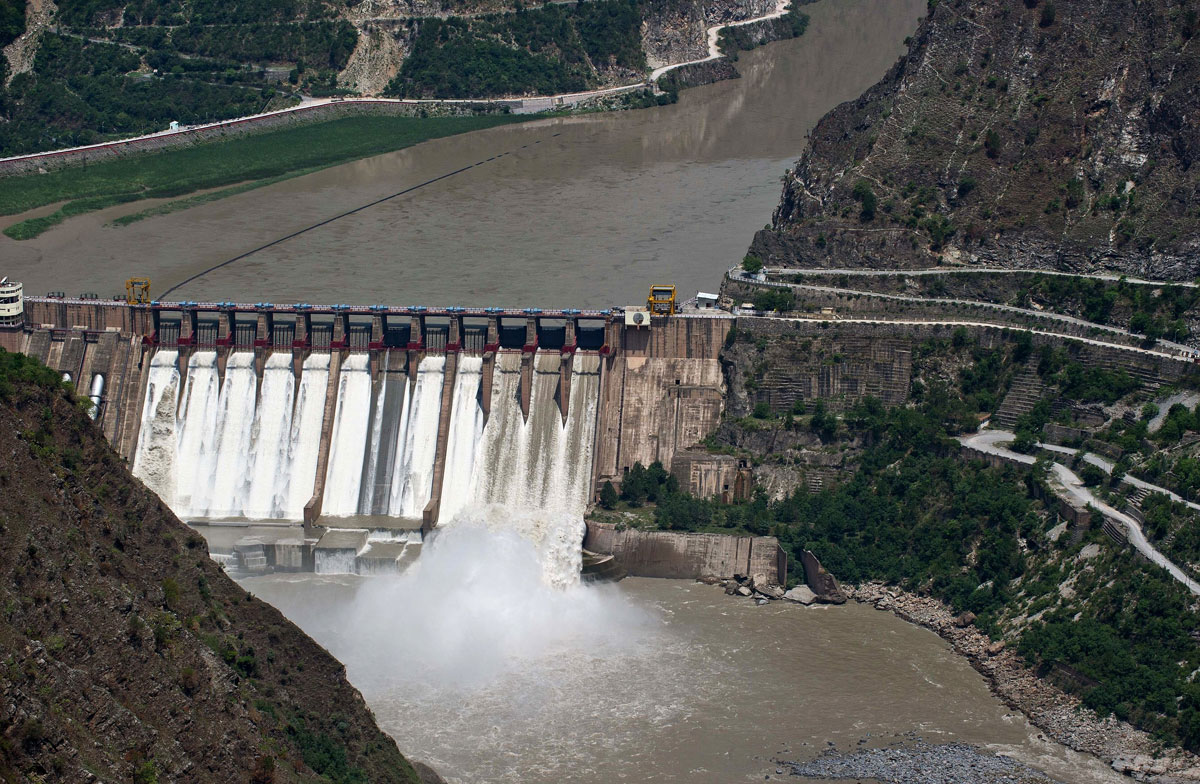FOCUS ON HYDRO
In this photograph taken on July 5, 2014, the Salal Hydro Power project dam on India’s Chenab river is seen in Riasi. Prime Minister Narendra Modi promises an era of fiscal prudence and greater opportunities for foreign investors in key sectors of the economy. (Prakash Singh | AFP | Getty Images)
Wind and solar energy are two abundant natural resources in India that the Modi government wants to tap to meet the country’s electricity needs. Over the recent weeks there has been some focus to harness India’s immense hydro resources as well. The Indian government is preparing a fresh framework to spur development of hydropower projects (HPP) by lowering project cost and removal of long-drawn clearances. These comments were made recently in New Delhi by B.P. Pandey, additional power secretary, a senior official, writes Siddharth Srivastava. (@Siliconeer, #Siliconeer, #india, @hydropower, #namo)
“The focus is going to be back on hydro. Hydropower is much cleaner, greener and sustainable option,” he said. Elaborating on the official thinking, Pandey said, “How do we bring down costs or tariff of hydro projects, can we overcome and remove some of the long-drawn clearance processes taking into account environmental safety as well and basin studies, can we also devise some innovative financing models in our instruments which may help to restore the investor confidence which as of now has gone down and people are really not investing apart from public sector units.” As reducing project cost of HPPs is the biggest challenge, Pandey suggested financial restructuring and innovative financing instruments, as possible solutions.
A report released in May by PwC and industry body ASSOCHAM has also emphasized the need to develop HPPs in India. According to PwC: “To meet the ambitious power generation targets expeditious hydropower development is needed, given its abundant potential of 148 GW. It is a clean source with minimal carbon trail, provides irrigation and flood control benefits via regulation of downstream water flow and has low operating cost. It provides significant ancillary benefits and has a long economic life of 40-50 years that can be enhanced to 100 years through timely renovations, helping in higher revenue generation.”
Echoing some of Pandey’s thoughts, the report says government’s intervention by offering fiscal incentives, creating new financing avenues and enabling infrastructure are critical. “New financing avenues need to be developed along with sufficient funding support from the government in order to attract investment in the sector,” the report says. The report projected that after dipping to historic low in FY16, India’s peak power deficit will start rising. “Hydropower is best suited to meeting peak power requirement,” the report says.
India’s generation is skewed towards coal-fired thermal power that accounts for 70% of total installed capacity and more than 80% of the total units generated. New Delhi is targeting an ambitious renewable capacity of 175,000 MW by 2022 that includes 100,000 MW solar, 60,000 MW wind and rest biomass and small hydro. India’s installed capacity for large hydro is over 42.5 GW, while for small hydro over 4200 MW. Currently, the portfolio of coal, power and renewable energy are being handled by the same minister, Piyush Goyal, in order to achieve coordinated development of multiple resources.
The ministry of new and renewable energy handles Small Hydro Power (SHP) projects up to 25 MW capacities which is mostly private investment driven. The importance of decentralized and off-grid power generation can be gauged from the fact that India’s solar target includes 40,000 MW from rooftop units.
In a significant move New Delhi has recently floated a mega tender of 500 MW for rooftop solar. SHP capacity in India is estimated about 20,000 MW. Most of the potential is in Himalayan States as river-based projects and in other states on irrigation canals. The emphasis on SHP is also important due to the inherent environmental risks, including floods, associated with large HPP. The major floods in Uttarakhand in June 2013 have been linked to big HPPs. India’s record of resettlement and rehabilitation of affected local populations is also very poor. Big capital-intensive hydropower projects, regulated by the power ministry, are not classified as generators of renewable energy in India. There is an ongoing debate that large HPPs, at least run-of-river plants, should be redefined as clean energy project. This will enable developers to access overseas capital, local subsidies and avail fiscal benefits extended to green energy producers.
In an earlier note PwC has said. “Large hydro in several European nations is also categorized as renewable. It will also place capital-intensive hydro favorably to secure financing flow anticipated post Paris.” Last year, the Association of Power Producers (APP) sought renewable energy status for HPPs. “For optimal load management, hydro needs to be around 40% of the energy mix. During the last three decades, hydro generation has deteriorated considerably. Hydro purchase obligation will help restore the balance,” APP said.
India’s three major state-owned power utilities: NTPC, National Hydro Power Corporation and Nuclear Power Corporation, on an average charge Rs 3.5 per unit for electricity generated. Large solar projects in India currently are being bid at Rs 4.5 to 5 per unit, which some consider to be too aggressive. While New Delhi is devising and fine-tuning policies linked to solar, wind, power and bio-fuel, hydro, has been largely ignored. The focus on the clean energy resource is welcome.


